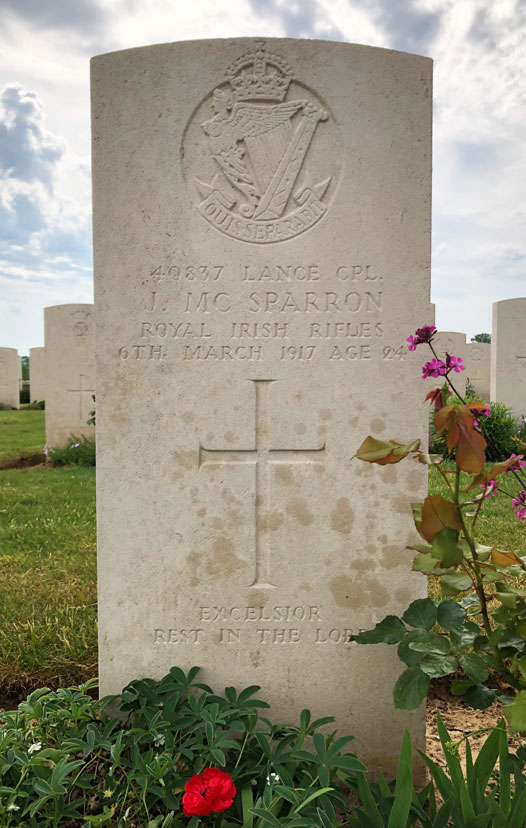![]() In memoriam
In memoriam ![]()
Lance Corporal John McSparron
John McSparron was born on 29 April 1893 in the village of Feeny, County Londonderry, son of gardener William James McSparron and his wife Fanny McSparron (nee Moore).
He enlisted in the North Irish Horse at Antrim in late November or early December 1915 (No.2006). In November 1916 McSparron, together with around 100 other North Irish Horsemen, volunteered to transfer to the Royal Irish Rifles (No.40837). They embarked for France on 7 December, where they joined the 1st Battalion, Royal Irish Rifles, on the Somme front.
At the beginning of March the battalion took part in a short but fierce attack in the sector in front of Bouchavesnes, captured by the French the previous September and only recently handed over to the BEF. The attack was a complete success. Within 40 minutes the objectives – Pallas Trench and Fritz Trench behind it – were seized. The consolidation took longer, with artillery bombardment and counter-attacks from an enemy not keen to be pushed out. The 1st Battalion Royal Irish Rifles, initially held in reserve, received orders to come up in relief at 6.00 pm. This from the Battalion’s war diary:
[4 March] Orders were received for the Battalion to march up and relieve 2 Lincolnshire Regiment and supporting companies of the 2 Rifle Brigade, the 2 R Berkshires still maintaining their position in the captured trenches. The Battalion therefore took up a position in the old British front line and support. The shelling during the night was severe. During the afternoon the enemy counter attacked and gained a footing in a part of the trench, 3 OR belonging to our Lewis Gunners but to 2 R Berks were killed.
At midday on 5 March the Battalion was ordered to relieve the 2nd Royal Berkshires in the front line. This they accomplished that night.
The shelling was again heavy. 1 OR was killed 3 OR wounded. D Coy held the new front line, C Coy were in Pallas Trench, A Coy in a new trench leading from Pallas to old British front line, B Coy in old British line.
[6 March] Shelling still severe but consolidation continued.
[7 March] 5 OR killed 19 OR wounded.
[8 March] 11pm. Battalion relieved in the front line by 2 Rifle Brigade, move to a base in Bouchavesne and Lock Barracks.
Records show that 27 men of the 1st Royal Irish Rifles were killed between 4 and 8 March. Among them were four former North Irish Horsemen – Riflemen William Nixon and John Nixon Gibson, and Lance Corporals John McSparron and Thomas Hall.
McSparron had died of wounds on 6 March. He was buried near where he fell, in the newly captured German trench system (map reference 62c.C.16.C.9.9), the location marked with a cross. After the war his body was moved to Fins New British Cemetery, Sorel-le-Grand, Somme, France, grave VIII.D.23.
His gravestone inscription reads:
40837 LANCE CPL.
J. MC SPARRON
ROYAL IRISH RIFLES
6TH MARCH 1917 AGE 24
EXCELSIOR
REST IN THE LORD

Images Copyright © Phillip Tardif with all rights reserved as set out in this Use of Material policy.

